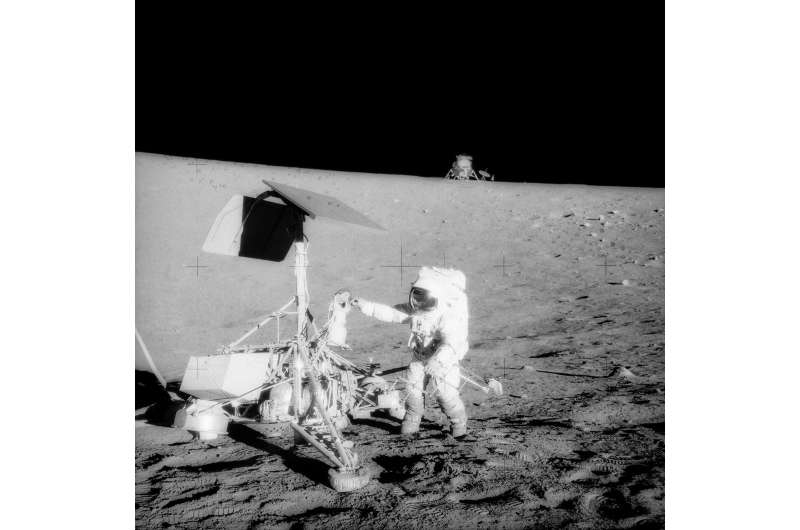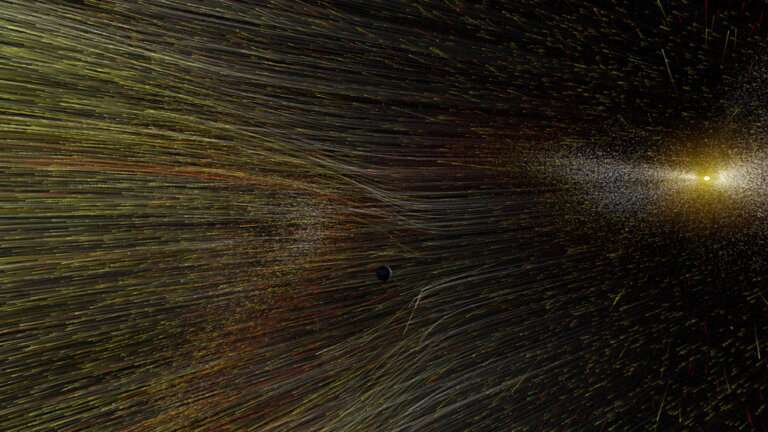This article has been reviewed according to Science X's editorial process and policies. Editors have highlighted the following attributes while ensuring the content's credibility:
fact-checked
trusted source
proofread
The long history and bright future of space sample deliveries

When NASA's OSIRIS-REx spacecraft releases a capsule with material from asteroid Bennu onto the Utah desert on Sept. 24, it will become the latest in a line of missions to gather samples from space and deliver them to Earth. Collecting material from space is a challenging feat that requires teams of dedicated scientists and engineers, innovative technology, and patience. But the scientific breakthroughs these samples unlock make the effort worthwhile as we attempt to understand the origins of our planet and the life that thrives here.
The practice of retrieving samples from space began in 1969 with NASA's Apollo 11 mission, the first to land astronauts on the moon. Many more sample-gathering missions to the moon and beyond followed, growing in ambition with each passing decade. Here is an overview of the history and future of missions, organized by NASA and its partners, to bring home pieces of space.
1969: NASA's moonwalk delivers first space samples
NASA astronaut Neil Armstrong's famous line, "That's one small step for [a] man, one giant leap for mankind," commemorated humanity's first footsteps on a world beyond Earth. It also launched a new era of science, engineering, and exploration. Apollo astronauts collected and returned 842 pounds (382 kilograms) of rocks and dust across six missions.
Because moon rocks are better preserved than Earth rocks, they offered unprecedented insight into how our planet and solar system formed—a history largely erased on Earth by erosion, climate cycles, volcanic activity, and plate tectonics. Among many other things, Apollo samples revealed that the makeup of the moon and Earth are so similar the two likely formed from the same material. This finding led scientists to theorize that the moon formed from rock and metal that flung off a collision between a young Earth and a Mars-size object about 4.5 billion years ago.

2004: Genesis grabs solar wind
NASA's Genesis spacecraft delivered the first samples from beyond the orbit of the moon in 2004. Placed for more than two years in a gravitationally stable point between the Earth and sun, the spacecraft collected charged particles streaming out from the sun, called the solar wind. Scientists wanted to study these particles because they are thought to reflect the chemical composition of the solar system when it was just forming nearly 4.6 billion years ago.
After analyzing the sample scientists were surprised to see that sun particles had different versions, or isotopes, of oxygen and nitrogen compared to Earth. They had expected the sun and planets to have similar isotopic signatures since everything in the solar system formed from the same cloud of gas and dust, called the solar nebula. One reason for the difference may be that Earth and the rest of the rocky, inner planets formed from the dust of the nebula, whereas the sun formed from both gas and dust.
2006: Collecting a comet's dusty halo
In 2006, NASA's Stardust mission became the first to collect comet samples and deliver them to Earth. Like the name suggests, Stardust captured dust particles—10,000 of them—from the halo of dust and gas, called a coma, surrounding comet Wild 2.
Scientists made some key discoveries after analyzing bits of Wild 2. Among them was the first detection of glycine in a comet. Glycine is an amino acid, which is a fundamental building block of Earth life. Finding glycine in comet dust supported the theory that some of life's ingredients formed in space and were delivered to Earth—and possibly other worlds—by comets and asteroids.
2010 and 2020: Going to the source for history of solar system
Asteroid dust—older and better preserved than any material on Earth—offers scientists a window into the birth of the solar system. The first studies of asteroid samples were made possible by JAXA (the Japan Aerospace Exploration Agency), when its Hayabusa spacecraft returned in 2010 with thousands of particles from asteroid Itokawa. Hayabusa2 followed with 0.2 ounces, or 5.4 grams, of asteroid Ryugu in 2020, far exceeding mission requirements.
Itokawa and Ryugu samples revealed the structure and chemical composition of "rubble pile" asteroids, which are made of rocks and boulders loosely held together by gravity. The samples also showed that some asteroids, as predicted, contain organic molecules, which could be some of the building blocks of all known life forms.
Soon, scientists will have an opportunity to compare Itokawa and Ryugu samples to pieces of asteroid Bennu, which are on their way to Earth now aboard the OSIRIS-REx spacecraft. Through an international agreement, NASA and JAXA are collaborating to analyze and compare samples from the three asteroids, two of which—Ryugu and Bennu—may have broken off the same parent asteroid billions of years ago.
2023: Cruising back to Earth with Bennu rocks
Setting out to collect at least 2 ounces, or 60 grams, of dust and rocks from Bennu, OSIRIS-REx is on its way home with an estimated 8.8 ounces, or 250 grams, of material, which is just over a cupful. OSIRIS-REx collected the sample from Bennu on Oct. 20, 2020. After the sample reaches Earth on Sept. 24, generations of scientists will get to probe dust from Bennu in their labs to address dozens of questions about the nature of asteroids, the early solar system, and the origins of life.
While at Bennu, the OSIRIS-REx spacecraft detected organic carbon and signs that the material Bennu is made of had interacted with liquid water in the past. When the samples reach Earth, scientists will be able to see the complete chemical makeup of Bennu and piece together the history of water and organic matter on the asteroid.
Future Missions
2029: Martian moons get the spotlight
JAXA will launch its MMX (Martian Moons eXploration) mission in 2024 to study the Martian moons Phobos and Deimos up close for the first time in history. MMX also will collect surface samples from Phobos, the farthest sampling location yet. JAXA will deliver the samples to Earth in 2029.
This mission, which includes a NASA instrument, technology-demonstration sampling system and NASA-supported participating scientists from U.S. institutions, will help address questions about the evolution of Mars and the formation of its two moons.
2033: The Red Planet comes to Earth
One of the big goals of space exploration is to determine whether Mars could have supported microbial life, or still does. Orbiters and rovers at the Red Planet have found intriguing evidence that early Mars had liquid water and a protective atmosphere, conditions that could have supported life as we know it. A portable lab in the belly of NASA's Curiosity rover has even detected organic molecules in Martian soil that may—or may not—be related to life. To try to settle the question of Martian habitability, scientists have dreamed for decades of bringing Martian material to Earth to analyze it with cutting-edge technologies that are too big and too complex to send to space.
Their dreams could soon come true, as NASA and ESA (the European Space Agency) are designing a multi-mission campaign to retrieve samples that NASA's Mars 2020 Perseverance rover is currently collecting from an ancient river delta in Jezero Crater. Called Mars Sample Return, the campaign is one of the most coordinated endeavors in spaceflight, involving multiple spacecraft, launches, and government agencies. The first spacecraft in a series needed to pick up Perseverance's samples and bring them to Earth is scheduled to launch in 2027.
Provided by NASA





















